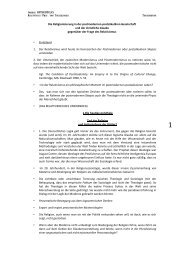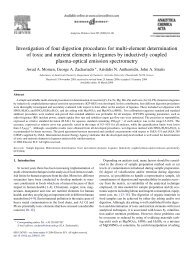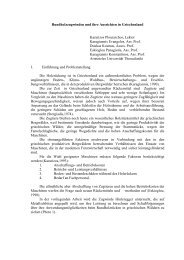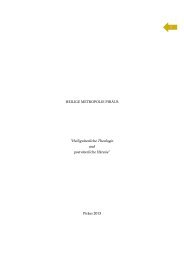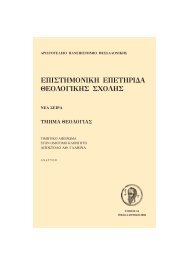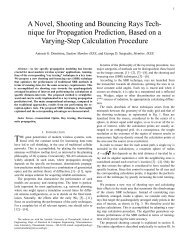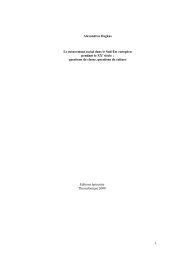an alternative proposal for the design of balanced cantilever bridges ...
an alternative proposal for the design of balanced cantilever bridges ...
an alternative proposal for the design of balanced cantilever bridges ...
You also want an ePaper? Increase the reach of your titles
YUMPU automatically turns print PDFs into web optimized ePapers that Google loves.
2 Proceedings IBSBI 2011<br />
20% <strong>of</strong> <strong>the</strong> length <strong>of</strong> <strong>the</strong> second sp<strong>an</strong> are casted toge<strong>the</strong>r. The construction <strong>of</strong><br />
<strong>the</strong> next bridge segment follows after <strong>the</strong> application <strong>of</strong> <strong>the</strong> prestressing <strong>for</strong>ce,<br />
while keeping <strong>the</strong> immediate prestress losses within normal levels. The final<br />
loading <strong>of</strong> <strong>the</strong> bridge due to <strong>the</strong> self-weight <strong>of</strong> <strong>the</strong> superstructure is varying with<br />
time due to <strong>the</strong> influence <strong>of</strong> <strong>the</strong> creep effect [3] [4].<br />
A new bridge construction method is investigated in this paper. The method has<br />
similarities with <strong>the</strong> bal<strong>an</strong>ced c<strong>an</strong>tilever method. The connection <strong>of</strong> <strong>the</strong><br />
c<strong>an</strong>tilevers is achieved by <strong>the</strong> use <strong>of</strong> tendon couplers. The tendons are straight<br />
<strong>an</strong>d <strong>the</strong> scaffolding, which is used <strong>for</strong> <strong>the</strong> deck casting, is removed after <strong>the</strong><br />
application <strong>of</strong> <strong>the</strong> prestressing <strong>for</strong>ce. The applicability <strong>of</strong> <strong>the</strong> proposed<br />
construction method has been attempted to a cast-in-situ benchmark bridge<br />
actually built along a major motorway that runs across Nor<strong>the</strong>rn Greece.<br />
2 THE PROPOSED CONSTRUCTION METHOD<br />
2.1 Structural assumptions<br />
The proposed structural method, which c<strong>an</strong> be utilised <strong>for</strong> <strong>the</strong> construction <strong>of</strong><br />
cast-in-situ <strong>bridges</strong>, is based on <strong>the</strong> following structural assumptions: (a) The<br />
deck cross section has a variable height along <strong>the</strong> longitudinal direction <strong>of</strong> <strong>the</strong><br />
bridge with a symmetrical bottom fl<strong>an</strong>ge, which is modulated by a polygonal<br />
shape inscribed in a parabolic arch, as shown in Figure 1. The cross section <strong>of</strong><br />
<strong>the</strong> deck c<strong>an</strong> be ei<strong>the</strong>r a box girder or a voided slab. (b) The prestressing<br />
tendons are straight <strong>an</strong>d continuous in all <strong>the</strong> deck sp<strong>an</strong>s <strong>an</strong>d <strong>the</strong>y are installed<br />
in <strong>the</strong> top fl<strong>an</strong>ge <strong>of</strong> <strong>the</strong> deck. The appropriate concrete cover [5] [6] is provided<br />
to protect <strong>the</strong> tendons against corrosion. Within <strong>the</strong> bottom fl<strong>an</strong>ge <strong>of</strong> <strong>the</strong> deck<br />
only ordinary strength steel is utilised. (c) The construction <strong>of</strong> <strong>the</strong> end sp<strong>an</strong>s c<strong>an</strong><br />
follow two different <strong>design</strong> <strong>alternative</strong>s: (c1) The first <strong>alternative</strong> introduces <strong>the</strong><br />
construction <strong>of</strong> <strong>the</strong> end sp<strong>an</strong>s by maintaining <strong>the</strong> geometry <strong>of</strong> <strong>the</strong> intermediate<br />
sp<strong>an</strong>s <strong>for</strong> reasons <strong>of</strong> aes<strong>the</strong>tics. In that case, <strong>the</strong> deck is chosen to be seated on a<br />
wall-like abutment web, as shown in Figure 1 <strong>an</strong>d 2. (c2) The second <strong>design</strong><br />
<strong>alternative</strong> introduces <strong>the</strong> construction <strong>of</strong> <strong>the</strong> end sp<strong>an</strong>s with lengths smaller<br />
th<strong>an</strong> <strong>the</strong> ones <strong>of</strong> <strong>the</strong> intermediate ones. Half <strong>of</strong> <strong>the</strong> length <strong>of</strong> <strong>the</strong> end sp<strong>an</strong> has a<br />
deck cross section with variable height. This corresponds to <strong>the</strong> part <strong>of</strong> <strong>the</strong> deck<br />
which extends from <strong>the</strong> end pier towards <strong>the</strong> abutment. The o<strong>the</strong>r part <strong>of</strong> <strong>the</strong><br />
sp<strong>an</strong> is seated through bearings to <strong>the</strong> abutment, as shown on <strong>the</strong> right abutment<br />
<strong>of</strong> Figure 1. It extends from <strong>the</strong> abutment towards <strong>the</strong> pier <strong>an</strong>d has a const<strong>an</strong>t<br />
cross section height. The need <strong>for</strong> <strong>the</strong> smaller length <strong>of</strong> <strong>the</strong> end sp<strong>an</strong>s was found<br />
to be dictated by <strong>the</strong> relatively small height <strong>of</strong> <strong>the</strong> deck cross section that is 0,80<br />
m <strong>an</strong>d by <strong>the</strong> use <strong>of</strong> ordinary rein<strong>for</strong>cements in <strong>the</strong> bottom fibre <strong>of</strong> <strong>the</strong> deck.<br />
It is noted that <strong>the</strong> use <strong>of</strong> prestressing within <strong>the</strong> bottom fl<strong>an</strong>ge <strong>of</strong> <strong>the</strong> deck was<br />
not deemed to be a rational <strong>design</strong> selection, as <strong>the</strong> tendons would induce a<br />
large vertical load downwards, due to <strong>the</strong> variation <strong>of</strong> <strong>the</strong> height <strong>of</strong> <strong>the</strong> deck<br />
cross section. This constraint loading, namely <strong>the</strong> one induced by possible



